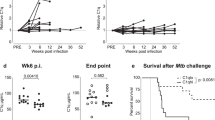Abstract
Systemic disease is the most severe clinical form of fusariosis, and the treatment involves a challenge due to the refractory response to antifungals. Treatment for murine Fusarium solani infection has been described in models that employ CFU quantitation in organs as a parameter of therapeutic efficacy. However, CFU counts do not precisely reproduce the amount of cells for filamentous fungi such as F. solani. In this study, we developed a murine model of disseminated fusariosis and compared the fungal burden with two methods: CFU and quantitative PCR. ICR and BALB/c mice received an intravenous injection of 1 × 107 conidia of F. solani per mouse. On days 2, 5, 7, and 9, mice from each mice strain were killed. The spleen and kidneys of each animal were removed and evaluated by qPCR and CFU determinations. Results from CFU assay indicated that the spleen and kidneys had almost the same fungal burden in both BALB/c and ICR mice during the days of the evaluation. In the qPCR assay, the spleen and kidney of each mouse strain had increased fungal burden in each determination throughout the entire experiment. The fungal load determined by the qPCR assay was significantly greater than that determined from CFU measurements of tissue. qPCR could be considered as a tool for quantitative evaluation of fungal burden in experimental disseminated F. solani infection.




Similar content being viewed by others
References
Nucci M, Anaissie E. Fusarium infections in immunocompromised patients. Clin Microbiol Rev. 2007;20:695–704.
Dignani MC, Anaissie E. Human fusariosis. Clin Microbiol Infect Dis. 2004;10(suppl 1):67–75.
Martino P, Gastaldi R, Raccah R, Girmenia C. Clinical patterns of Fusarium infections in immunocompromised patients. J Infect. 1994;28(suppl 1):7–15.
Walsh TJ, Groll AH. Emerging fungal pathogens: evolving challenges to immunocompromised patients for the twenty-first century. Transpl Infect Dis. 1999;1:247–61.
Girmenia C, Pagano L, Corvatta L, Mele L, del Favero A, Martino P. The epidemiology of fusariosis in patients with haematological diseases. Br J Haematol. 2000;111:272–6.
Pontón J, Rüchel R, Clemons KV, Coleman DC, Grillot R, Guarro J, Aldebert D, Ambroise-Thomas P, Cano J, Carrillo-Muñoz AJ, Gené J, Pinel C, Stevens DA, Sullivan DJ. Emerging pathogens. Med Mycol. 2000;38(suppl 1):S225–36.
Mayayo E, Pujol I, Guarro J. Experimental pathogenicity of four opportunist Fusarium species in a murine model. J Med Microbiol. 1999;48:363–6.
Azor M, Gene J, Cano J, Guarro J. Universal in vitro antifungal resistance of genetic clades of the Fusarium solani species complex. Antimicrob Agents Chemother. 2007;51:1500–3.
Alastruey-Izquierdo A, Cuenca-Estrella M, Monzón A, Mellado E, Rodríguez-Tudela JL. Antifungal susceptibility profile of clinical Fusarium spp. Isolates identified by molecular methods. J Antimicrob Chemother. 2008;61:805–9.
O′Donnell K, Sutton DA, Fothergill A, McCarthy D, Rinaldi MG, Brandt ME, Zhang N, Geiser DM. Molecular phylogenetic, multilocus haplotype nomenclature, and in vitro antifungal resistance within the Fusarium solani species complex. J Clin Microbiol. 2008;46:2477–90.
Nucci M, Marr KA, Queiroz-Telles F, Martins CA, Trabasso P, Costa S, Voltarelli JC, Colombo AL, Imhof A, Pasquini R, Maiolino A, Souza CA, Anaissie E. Fusarium infection in hematopoietic stem cell transplant recipients. Clin Infect Dis. 2004;38:1237–42.
Perfect JR, Marr KA, Walsh TJ, Greenberg RN, DuPont B, de la Torre-Cisneros J, Just-Nübling G, Schlamm HT, Lutsar I, Espinel-Ingroff A, Johnson E. Voriconazole treatment for less-common, emerging, or refractory fungal infections. Clin Infect Dis. 2003;36:1122–31.
Raad II, Hachem RY, Herbrecht R, Graybill JR, Hare R, Corcoran G, Kontoyiannis DP. Posaconazole as salvage treatment for invasive fusariosis in patients with underlying hematologic malignancy and other conditions. Clin Infect Dis. 2006;42:1398–403.
Lozano-Chiu M, Arikan S, Paetznick VL, Anaissie EJ, Loebenberg D, Rex JH. Treatment of murine fusariosis with SCH56592. Antimicrob Agents Chemother. 1999;43:589–91.
Spellberg B, Schwartz J, Fu Y, Avanesian V, Adler-Moore J, Edwards JE Jr, Ibrahim AS. Comparison of antifungal treatments for murine fusariosis. J Antimicrob Chemother. 2006;58:973–9.
Ruíz-Cendoya M, Mariné M, Guarro J. Combined therapy in treatment of murine infection by Fusarium solani. J Antimicrob Chemother. 2008;62:543–6.
Wiederhold NP, Najvar LK, Bocanegra R, Graybill JR, Patterson TF. Efficacy of posaconazole as treatment and prophylaxis against Fusarium solani. Antimicrob Agents Chemother. 2010;54:1055–9.
Nelson PE, Tousson TA, Marasas WFO. Fusarium species: an illustrated manual for identification. University Park, PA: Pennsylvania State University Press; 1983.
Rosa RH Jr, Miller D, Alfonso EC. The changing spectrum of fungal keratitis in south Florida. Ophthalmology. 1994;101:1005–13.
Doyle JJ, Doyle JL. A rapid DNA isolation procedure for small quantities of fresh leaf tissue. Phytochem Bull. 1987;19:11–5.
Cullings KW. Design and testing of a plant-specific PCR primer for ecological and evolutionary studies. Mol Ecol. 1992;1:233–40.
Jaeger EE, Carroll NM, Choudhury S, Dunlop AA, Towler HM, Matheson MM, Adamson P, Okhravi N, Lightman S. Rapid detection and identification of Candida, Aspergillus, and Fusarium species in ocular samples using nested PCR. J Clin Microbiol. 2000;38:2902–8.
Walsh TJ, McEntee C, Dixon DM. Tissue homogenization with sterile reinforced polyethylene bags for quantitative culture of Candida albicans. J Clin Microbiol. 1987;25:931–2.
Latgé JP. Aspergillus fumigatus and aspergillosis. Clin Microbiol Rev. 1999;12:310–50.
Acknowledgements
We thank Sergio Lozano-Rodriguez, M.D. for his review of the manuscript prior to submission.
Conflict of interest
The authors declare that no conflict of interest.
Author information
Authors and Affiliations
Corresponding author
Rights and permissions
About this article
Cite this article
González, G.M., Márquez, J., Treviño-Rangel, R.J. et al. Murine Model of Disseminated Fusariosis: Evaluation of the Fungal Burden by Traditional CFU and Quantitative PCR. Mycopathologia 176, 219–224 (2013). https://doi.org/10.1007/s11046-013-9687-3
Received:
Accepted:
Published:
Issue Date:
DOI: https://doi.org/10.1007/s11046-013-9687-3



